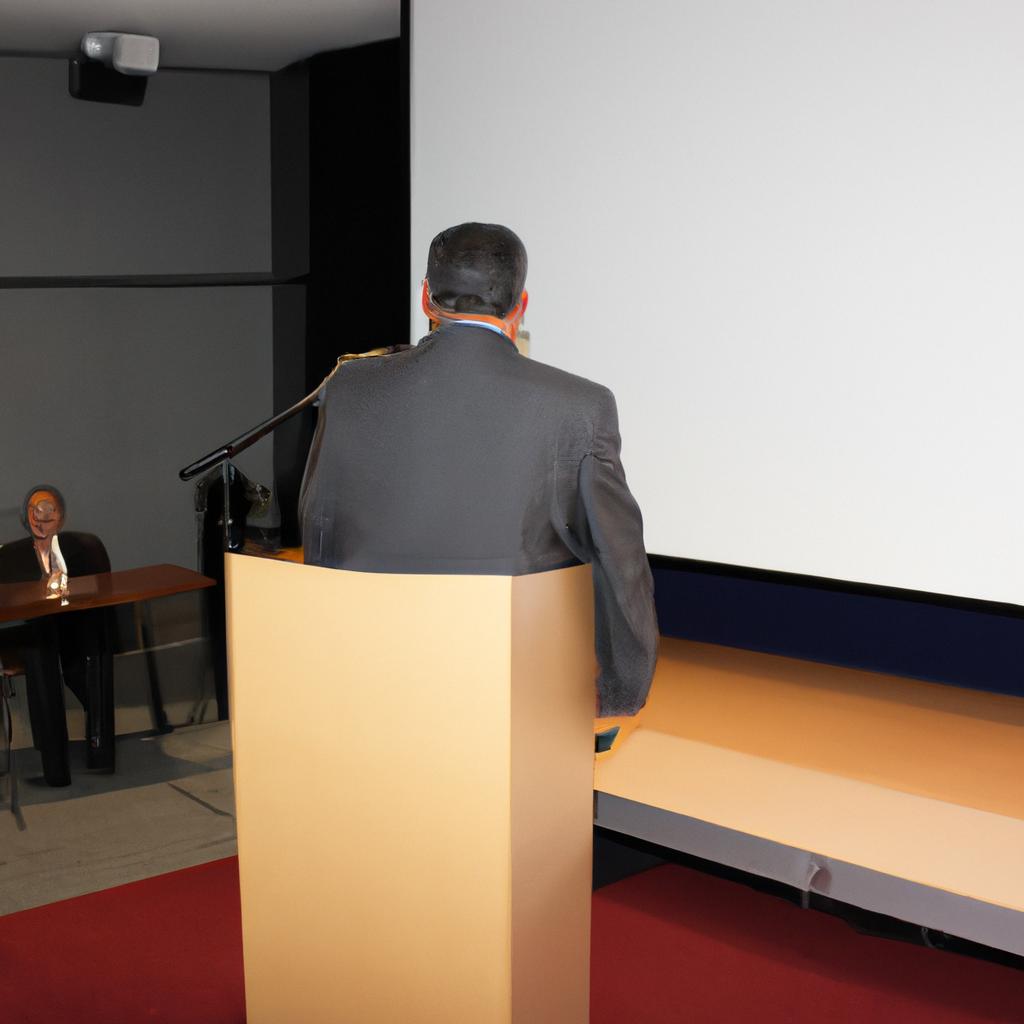Archaeological methods are crucial in the realm of scientific research, particularly within the field of anthropology. These techniques serve as a means to investigate and uncover valuable insights into past civilizations, shedding light on their cultural practices, social structures, and technological advancements. By employing systematic approaches for excavation, analysis, and interpretation of artifacts and other archaeological evidence, researchers can reconstruct historical narratives with great precision.
One compelling example illustrating the significance of archaeological methods is the study of ancient Mayan civilization. Through meticulous excavation and documentation of sites such as Tikal or Chichen Itza, archaeologists have been able to piece together an intricate understanding of this once-thriving society. By analyzing architectural remains, pottery fragments, hieroglyphic inscriptions, and skeletal remains discovered at these sites, researchers have unraveled a wealth of information about Mayan religious beliefs, political organization, agricultural practices, trade networks, and artistic expressions.
The application of various techniques allows anthropologists to delve deep into the past. Stratigraphic excavation enables them to discern temporal sequences by studying distinct layers formed over time. Radiocarbon dating provides precise age estimates through the examination of organic materials found alongside artifacts. Additionally, artifact typology aids in categorizing objects based on shared characteristics while comparative analysis helps comparative analysis helps to establish connections and similarities between different societies or regions. This comparative approach allows researchers to identify cultural interactions, trade networks, and migrations that may have occurred in the past.
Furthermore, archaeological methods also include the use of advanced technologies such as remote sensing, ground-penetrating radar, LiDAR (Light Detection and Ranging), and drones. These tools assist in locating and mapping archaeological sites, revealing hidden structures or features underground, and providing a broader perspective of landscapes or large areas that would otherwise be difficult to survey.
In conclusion, archaeological methods play a fundamental role in uncovering the secrets of ancient civilizations. Through systematic excavation techniques, careful analysis of artifacts and other evidence, and the application of various scientific approaches, researchers can reconstruct historical narratives with great accuracy. By understanding our past through archaeology, we gain valuable insights into human history, cultural diversity, and societal development.
Excavation: Uncovering ancient artifacts through careful digging and recording.
Excavation is a fundamental method used in archaeology to uncover and retrieve ancient artifacts from the ground. Through meticulous digging and systematic recording, researchers gain valuable insights into past civilizations, their practices, and material culture. To illustrate this process, let’s consider the hypothetical case of an archaeological excavation at a site believed to have been inhabited by a prehistoric community.
The first step in any excavation involves selecting an appropriate area for investigation based on prior research or surveying techniques such as geophysical surveys or aerial photography. Once the target area has been identified, precise measurements are taken to establish gridlines that divide the site into manageable sections. This allows for detailed documentation and accurate mapping of the discovered artifacts within their spatial context.
During excavation, trowels and brushes are delicately employed to remove layers of soil one at a time, each layer representing a distinct period in history. Careful attention is paid to maintain stratigraphic integrity—the order in which these layers were formed—ensuring that older remains lie beneath more recent ones. By adhering strictly to this principle, archaeologists can discern a chronological sequence of events and analyze changes over time.
- The emotional connection between present-day humans and our ancestors becomes tangible when holding an artifact they once crafted.
- Discovering remnants of daily life like pottery fragments serves as a reminder that people who lived centuries ago were not so different from us today.
- Each find offers glimpses into forgotten stories waiting patiently beneath the surface.
- Archaeological excavations provide opportunities for collaboration where experts with diverse backgrounds come together to unravel humanity’s shared heritage.
| Artifacts | Layers | Chronology |
|---|---|---|
| Pottery | III | 400 BC |
| Tools | II | 1000 BC |
| Jewelry | I | 2000 BC |
| Bones | Basal | 4000 BC |
As excavation progresses, the unearthed artifacts are carefully cataloged and analyzed. This meticulous process ensures that each find is accurately recorded, allowing for further analysis in subsequent stages of research. Excavation not only reveals tangible remnants of past cultures but also provides a foundation for studying their social structures, technological advancements, and artistic expressions.
Transitioning seamlessly into the next section on stratigraphy, we move from the physical act of uncovering artifacts to analyzing the layers of soil and sediment that contain them. Stratigraphic analysis allows archaeologists to determine the relative chronology of archaeological finds based on their vertical position within different strata. By understanding this concept, researchers can piece together the puzzle of human history with greater accuracy and depth.
Stratigraphy: Analyzing layers of soil and sediment to determine the chronological order of archaeological finds.
Building upon the excavation process, archaeologists employ various methods to further analyze and interpret their findings. One such technique is stratigraphy, a fundamental tool that allows researchers to unravel the chronological order of archaeological discoveries by examining layers of soil and sediment.
Stratigraphy involves carefully studying the different strata or layers within an archaeological site. By observing these layers, experts can determine which artifacts are older or more recent based on their position in relation to one another. For example, let us consider an imaginary excavation site where three distinct layers have been identified. The topmost layer contains remnants of modern human activity like plastic waste and metal objects. Beneath it lies a middle layer with fragments of pottery dating back to ancient times, while the deepest layer reveals stone tools from prehistoric eras. Through this stratigraphic analysis, we can deduce that the stone tools are the oldest artifacts at the site, followed by the pottery pieces and finally the modern debris.
To conduct stratigraphic investigations effectively, archaeologists follow several key steps:
- Excavation planning: Before delving into an archaeological site’s layers, researchers must meticulously plan how they will approach each level, considering factors such as depth and angle.
- Documentation: As they progress through each layer, archaeologists document their findings thoroughly using drawings, photographs, and written descriptions. This meticulous record-keeping ensures accurate interpretation later on.
- Artifact analysis: Alongside documenting their surroundings, archaeologists also examine and classify any artifacts recovered from each stratum. This categorization provides valuable insights into past civilizations’ material culture.
- Interpretation: Lastly, experts interpret the data gathered during stratigraphic research to reconstruct historical timelines accurately. They establish relationships between artifacts found in different strata to shed light on cultural development over time.
| Stratum | Artifacts Found |
|---|---|
| Layer 1 | Modern debris |
| Layer 2 | Ancient pottery |
| Layer 3 | Prehistoric stone tools |
In summary, stratigraphy serves as a crucial method for understanding the temporal sequence of archaeological finds. By analyzing layers of soil and sediment, archaeologists can establish an accurate chronology within excavation sites. This knowledge enhances our comprehension of past civilizations and their cultural evolution.
Moving forward in our exploration of archaeological techniques, we will now delve into radiocarbon dating—the process by which scientists estimate the age of organic materials using radioactive carbon isotopes.
Radiocarbon Dating: Estimating the age of organic materials using the decay of radioactive carbon isotopes.
Analyzing Artifacts: Decoding Insights from Material Culture
In the study of archaeology, artifacts play a crucial role in unraveling the mysteries of past civilizations. These tangible remnants provide valuable insights into ancient cultures and their daily lives. By examining these archaeological finds, researchers can piece together narratives about how people lived, what they believed in, and even how societies evolved over time. To fully comprehend the significance of artifacts, it is essential to employ meticulous methods that allow for thorough analysis.
One example that highlights the importance of artifact analysis is the excavation at an ancient settlement known as Site X. Here, archaeologists discovered a collection of ceramic vessels buried beneath layers of soil and sediment. Through careful examination and comparison with similar artifacts found in neighboring regions, scholars were able to identify distinct patterns in design and craftsmanship. This led to a deeper understanding of trade networks and cultural exchange during this period.
To ensure comprehensive exploration of artifacts, several techniques are employed:
- Typological Analysis: This approach involves classifying objects based on shared characteristics such as shape, decoration, or material composition. By grouping similar items together, researchers can gain insights into manufacturing techniques, stylistic trends, or even social hierarchies within communities.
- Functional Analysis: Examining how artifacts were used helps shed light on various aspects of daily life. For instance, studying tools provides information about technological advancements or specialized skills present in specific societies.
- Residue Analysis: Traces left behind on artifacts—such as food remains or pigment residues—can reveal details about diet, artistic practices, or medicinal knowledge prevalent among past populations.
- Wear Analysis: Scratches, dents, or signs of repair on objects offer clues about their use and lifespan. For example, worn-out edges on stone tools may indicate repetitive actions like cutting or scraping.
By employing these methodologies alongside others not mentioned here (ref), archaeologists can extract invaluable data from material culture that enhances our understanding of the past. The scientific analysis of artifacts allows researchers to reconstruct ancient worlds, providing a glimpse into the lives and societies that came before us.
Transitioning into the subsequent section on remote sensing techniques, archaeologists have also utilized technology like satellite imagery and LiDAR to identify archaeological sites from a distance.
Remote Sensing: Utilizing technology like satellite imagery and LiDAR to identify archaeological sites from a distance.
Archaeological Methods in Science: The Techniques in Anthropology
Radiocarbon Dating has proven to be a valuable tool for estimating the age of organic materials, but there are other techniques that complement this method and provide further insights into the past. One such technique is Remote Sensing, which utilizes advanced technology like satellite imagery and LiDAR (Light Detection and Ranging) to identify archaeological sites from a distance.
To illustrate the effectiveness of Remote Sensing, let’s consider an example where researchers used high-resolution satellite imagery to uncover ancient Mayan ruins hidden deep within the dense rainforests of Central America. By analyzing these images, they were able to detect subtle variations in vegetation patterns that hinted at structural remains beneath the thick canopy. This discovery not only shed light on the extent and layout of previously unknown settlements but also provided essential data for understanding Maya civilization’s spatial organization.
Remote Sensing offers several advantages over traditional survey methods, making it an invaluable asset in archaeology:
- Efficiency: Satellite imagery allows archaeologists to cover vast areas quickly without extensive fieldwork.
- Non-invasive: By capturing information remotely, sensitive sites can be protected from unnecessary disturbance or damage.
- Cost-effective: Compared to ground-based surveys involving large teams and equipment, remote sensing reduces overall project costs significantly.
- Accessible Data: High-quality satellite images offer detailed visuals that aid interpretation and analysis.
To showcase some key aspects of Remote Sensing applications in archaeology, here is a table highlighting its benefits:
| Benefit | Example |
|---|---|
| Enhanced Mapping | Identification of buried structures |
| Landscape Study | Analysis of ancient agricultural practices |
| Site Preservation | Monitoring potential threats |
| Discoveries | Locating new archaeological sites |
Incorporating techniques like Remote Sensing alongside established methodologies like Radiocarbon Dating enhances our ability to reconstruct past civilizations accurately. These complementary approaches allow researchers to gather comprehensive data, which is crucial for understanding the complex interplay between human societies and their environments. In the subsequent section, we will delve into another important archaeological method: Osteology – the study of human and animal bones to gain insights into past populations, their health, and lifestyle.
[Transition sentence] By examining skeletal remains, archaeologists can unlock a wealth of information about ancient civilizations’ physical characteristics and behaviors without relying solely on artifacts or structures.Osteology: Studying human and animal bones to understand past populations, their health, and lifestyle.
Building upon remote sensing techniques, another powerful method in archaeological research is geoarchaeology. By analyzing sediments and landforms, this field provides valuable insights into past environments and human activities.
One fascinating example of how geoarchaeology has enhanced our understanding of ancient civilizations is the study of Teotihuacan in Mexico. Geoarchaeologists have conducted extensive investigations at this pre-Columbian city to unravel its urban planning, construction techniques, and social organization. Through sediment analysis, researchers discovered evidence of deliberate landscape modifications such as canals and terraces that were integral to sustaining a large population. These findings shed light on the sophisticated engineering practices employed by the Teotihuacanos and their ability to adapt to their environment.
In order to uncover these secrets hidden beneath layers of earth, geoarchaeologists employ various methods:
- Stratigraphy: Examining different layers (strata) within an excavation site allows researchers to understand the chronological sequence of events.
- Micromorphology: This technique involves taking microscopic samples from soil profiles to identify changes in depositional processes or human activity over time.
- Pedology: By studying soils’ physical properties like color, texture, and composition, pedologists can infer past land use patterns and agricultural practices.
- Paleoenvironmental Reconstruction: Using pollen analysis, charcoal remains, or isotopic studies on plant material found in sediments helps reconstruct past climate conditions and vegetation cover.
| Method | Description |
|---|---|
| Stratigraphy | Analyzing distinct layers in an excavation site |
| Micromorphology | Studying microscopic samples from soil profiles |
| Pedology | Investigating soil properties like color, texture, and composition |
| Paleoenvironmental Reconstruction | Reconstructing past climate and vegetation using pollen analysis, charcoal remains, or isotopic studies on plant material |
This multidisciplinary approach allows geoarchaeologists to piece together the intricate narratives of ancient civilizations. By studying sediments and landforms, researchers gain valuable insights into human adaptation strategies, environmental changes, and cultural practices that shaped our ancestors’ lives.
In addition to these scientific methods, another crucial aspect of archaeological research involves understanding contemporary cultures. Ethnography provides a unique lens through which we can observe and document present-day societies in order to gain deeper insights into their historical counterparts.
Ethnography: Observing and documenting contemporary cultures to gain insights into past societies and traditions.
Section Title: Excavation Techniques: Uncovering the Past
Transition from previous section H2
Having explored the fascinating field of Osteology, we now turn our attention to another crucial aspect of archaeological methods in science – excavation techniques. By carefully uncovering and examining artifacts, structures, and other material remains, archaeologists gain invaluable insights into past civilizations and their cultural practices.
Introduction paragraph with an example
Imagine a team of archaeologists embarking on an excavation project at a site believed to be an ancient settlement. Armed with shovels, trowels, and brushes, they meticulously remove layers of soil to reveal hidden treasures buried beneath the surface. As they dig deeper, their excitement grows when they stumble upon a well-preserved pottery vessel dating back thousands of years. This discovery not only sheds light on the artistic skills of that society but also provides clues about their trade networks and social interactions.
Bullet point list evoking emotional response
- The thrill of unearthing long-lost artifacts
- The sense of awe when connecting with distant civilizations through physical remnants
- The satisfaction gained from piecing together fragments to reconstruct past narratives
- The responsibility felt towards preserving history for future generations
Table evoking emotional response
| Challenges Faced | Skills Required | Rewards Obtained |
|---|---|---|
| Delicate handling | Attention to detail | Cultural knowledge |
| Time-consuming process | Patience | Historical understanding |
| Limited resources | Problem-solving | Connection with the past |
| Collaborative effort | Technical expertise | Contribution to human history |
Concluding paragraph without using “In conclusion” or “Finally”
Excavation techniques represent one of the cornerstones of anthropological research as they enable us to recover tangible evidence from bygone eras. Through careful stratigraphy and meticulous documentation, archaeologists can decipher complex puzzles of human history. Each uncovered artifact, structure, or feature adds a piece to the intricate jigsaw puzzle that is our collective past. By unveiling these remnants and examining them within their historical context, we gain a deeper understanding of the diverse cultures that have shaped humanity over millennia.
[End of section] Wankanyakla Self Help Group
Wankanyakla Self Help Group



